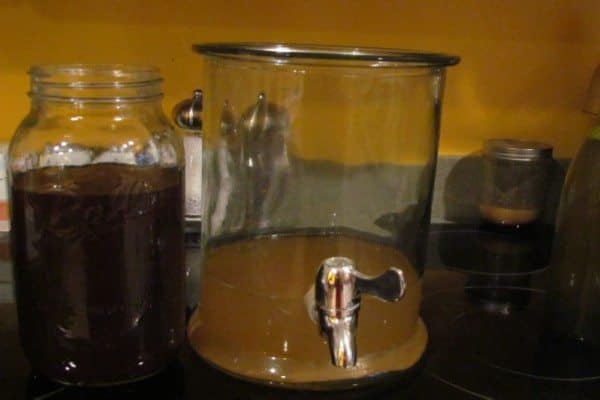What is Second Fermented Kombucha?

Kombucha is fermented sweet tea created by the action of the microorganisms in the kombucha SCOBY (Symbiotic Colony Of Bacteria and Yeast). This liquid is full of nutrients: organic acids, probiotics, vitamin C and vitamin B-complex, trace minerals, and even a bit of fiber.
There’s a little bit of sweetness, and maybe more than a little sourness, depending on how long the kombucha has brewed (primary fermentation) before the SCOBY is removed from the liquid. There’s a little bit of bubbliness from the residual carbon dioxide produced by the fermentation process. There’s a little alcohol, but not much. And while there’s a lot of flavor, it’s simply that sweet-tart kombucha flavor that some people compare to apple cider vinegar. When people want to add more carbonation to kombucha or increase the alcohol in kombucha, they use a process called second fermentation.
Second Fermentation
Primary fermentation is an aerobic process, during which the brewing container is covered by a thin cloth that keeps out contamination while allowing oxygen to flow into the container and carbon dioxide to flow out (“aerobic” means “with oxygen”). The yeasts in the SCOBY use the oxygen to help break down the sugars in the sweetened tea, and produces carbon dioxide (CO2) and ethanol, a type of alcohol. The bacteria in the SCOBY take the ethanol and the leftover sugars and convert them into organic acids and other nutrients.
To make second ferment kombucha, you put the liquid from the first fermentation into an oxygen-deprived anaerobic (“without oxygen”) environment, without the SCOBY. There are still active yeasts and bacteria in the liquid tea, and these will continue to process the sugar and ethanol, though at a slightly slower speed.
Increased Carbonation
Carbonation is increased during second fermentation because the containers are sealed, allowing the CO2 to build up as the yeasts continue to process the residual sugars. This means that if you’re planning on making second ferment kombucha, you need to get a supply of bottles for kombucha that allow you to create tight seals on the bottles, and also to be able to release the carbonation safely. Many people like to use the swing-top or flip-top bottles commonly called “Grolsch bottles” because they’re durable, easy to fill, and easy to clean.
The natural action of the yeast does produce extra carbonation, but you can also add additional ingredients that will provide even more CO2.
- Adding more sugar will give the yeast more food, which means it will produce more byproducts (ethanol and CO2).
- Adding fresh ginger will create natural carbonation in addition to the CO2 produced by the yeasts.
- Adding fresh fruit or fruit juice will provide the yeast with extra sugar, and will also create CO2 as the fruit itself ferments. Pineapple is a particularly fizzy fruit.
- Adding extra yeast along with the sugar and/or fresh fruit juice will definitely increase your carbonation, so if you choose this method be sure you have good equipment. This also tends to increase the alcohol content.
Increased Alcohol
A glass of fresh kombucha tea generally has less than 25% of the alcohol of beer. Due to a 2010 regulation passed down by the Food and Drug Administration, all commercial kombucha has to have less than 0.5%ABV (alcohol by volume) unless it is packaged and sold as an alcoholic beverage. Most home brewers, especially those with children, don’t worry too much about the alcohol level of their freshly-brewed kombucha because it’s so low.
However, during secondary fermentation the kombucha tea continues to ferment, and the alcohol levels will rise. If you simply bottle your kombucha tea without adding any other ingredients, you won’t get much of a gain in ABV. When you add extra sugar (whether organic cane sugar or sugary fresh fruit) you’ll give the yeast more to feed on, so it will produce more alcohol. The alcohol level will still probably not rise beyond 3% unless you add extra yeast as well.
NOTE: If you add extra yeast, then it’s a good idea to think of the process as making kombucha wine, and using the techniques that winemakers use to get good flavor while still keeping the finished product safe to drink. Click here for complete instructions on making kombucha alcohol.
Increased Flavor
It’s easy to mix freshly-brewed kombucha tea with sparkling water or fruit juice to change the flavor, but it’s almost as easy to add flavor during second fermentation. The third reason that people do a second ferment of their kombucha tea is to add flavor. During primary fermentation, it’s not a good idea to add ingredients that will negatively affect the brewing process, or harm the SCOBY. Adding extra ingredients increases the risk of getting mold on the SCOBY or allowing harmful bacteria to contaminate the kombucha tea. In general, the kombucha brewing process produces enough acids to keep out most bacteria and molds, but if the process is slowed down or changed by the additional ingredients, the pH may not stay at the level at which kombucha tea is safe to drink.
When you’ve removed the SCOBY, however, you can add almost any ingredient you like, and since you’re closing the brew inside sealed containers, there’s much less risk of contamination.
Here are some ways that you can add flavor to kombucha during the second fermentation:
- Add apple juice, maple syrup, and a cinnamon stick to get a sweet and spicy kombucha tea.
- Make your kombucha even more healthy by adding medicinal herbs like peppermint (good for an upset stomach) or rose hips (for a boost of vitamin C).
- Create your own margarita mix by adding lime juice, orange juice, and piloncillo (Mexican brown sugar). As an added benefit, one of the health benefits of kombucha is to support the liver and detoxify the system after alcohol. You’ll get the night before, without the morning after!
Click here for complete instructions on making second ferment kombucha.




